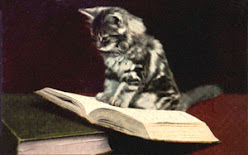Aa Bb Cc Dd Ee Ff Gg Hh Ii
Jj Kk Ll Mm Nn Oo Pp Qq Rr
Ss Tt Uu Vv Ww Xx Yy Zz
Your child needs to be able to identify all letters when your child starts reading in 1st Grade. It is harder to identify some letters when they are mixed with others; b, d, g, p, q are tricky because they are reversed images. Also, in print there are two symbols for lowercase g. Arial font g and Times New Roman g. (Both g symbols have a fancy tail - use that clue.) Also, Arial capital I and Times capital I. Arial capital I is the same as lowercase letter l, as in lamb. I am naming these fonts in case this blog self-corrects to Arial.
If your child is just starting to learn his ABCs, begin with letter Aa. Explain that just as people have special dress-up times, like going to church, our ABCs have dress-up times, too.
Tell your child letter Aa has a dress-up look for being the 1st letter in someone's name, like Adam or Anna. You print a large A on a sheet of paper. Ask your child to run his pointer finger several times over your A. Then give your child a crayon or pencil; ask your child to make As that looks like your A. Children do not have good finger muscle control - all letters will be wobbly and huge.
Now you make a large lower-case letter a on paper. Your letter a will be a circle with a line on the right side. Let your child run his pointer finger several times over your letter a. Tell your child this is called small letter a because it is not the dressed up letter A. Let him work on making letter a on paper.
Later, play this game. Take his capital dress-up A and place it in plain sight somewhere in the room. Place his small letter a in a different spot in the room. You and your child take turns placing and finding the dress-up A, also called capital A. Also take turns looking for small a, also called lower-case letter a. Small a is used for all the other words like ant, alligator, ankle, all, apple, and inside of words like cat, car, card, cap, can, call.
You can write these words on cards and hide them around the room. Ask if your child can find a dressed-up capital A word card, like Anna? Can he find a small a word card, like ant or cat? As your child is ready, teach letters B and b in the same way. Always start by reviewing all letters you have worked on in previous lessons.
Do not obsess over the printing of backward letters, they will not slow your child' s progress, are rarely dyslexia, self-correct by mid 2nd Grade. But, b, d, g, p, q must be correctly printed. Also, look for b in words as you read stories together. (Then, target d, then g, etc.) Goal: Your child needs to be able to identify b, d, g, p, q within words by early 1st Grade.
Tell your child letter Aa has a dress-up look for being the 1st letter in someone's name, like Adam or Anna. You print a large A on a sheet of paper. Ask your child to run his pointer finger several times over your A. Then give your child a crayon or pencil; ask your child to make As that looks like your A. Children do not have good finger muscle control - all letters will be wobbly and huge.
Now you make a large lower-case letter a on paper. Your letter a will be a circle with a line on the right side. Let your child run his pointer finger several times over your letter a. Tell your child this is called small letter a because it is not the dressed up letter A. Let him work on making letter a on paper.
Later, play this game. Take his capital dress-up A and place it in plain sight somewhere in the room. Place his small letter a in a different spot in the room. You and your child take turns placing and finding the dress-up A, also called capital A. Also take turns looking for small a, also called lower-case letter a. Small a is used for all the other words like ant, alligator, ankle, all, apple, and inside of words like cat, car, card, cap, can, call.
You can write these words on cards and hide them around the room. Ask if your child can find a dressed-up capital A word card, like Anna? Can he find a small a word card, like ant or cat? As your child is ready, teach letters B and b in the same way. Always start by reviewing all letters you have worked on in previous lessons.
Do not obsess over the printing of backward letters, they will not slow your child' s progress, are rarely dyslexia, self-correct by mid 2nd Grade. But, b, d, g, p, q must be correctly printed. Also, look for b in words as you read stories together. (Then, target d, then g, etc.) Goal: Your child needs to be able to identify b, d, g, p, q within words by early 1st Grade.
My Panda book teaches reading for the beginning reader.
I use ebay as my website. Search Instant Reading Help all my books will pop up. All are brand new and include my contact info; email or call for help.
Have a great day, Mary Maisner
Have a great day, Mary Maisner

No comments:
Post a Comment